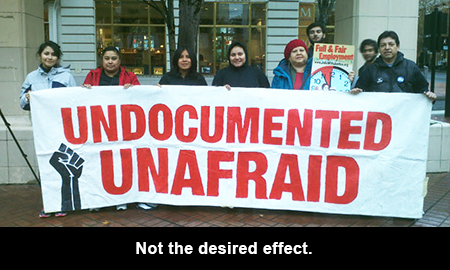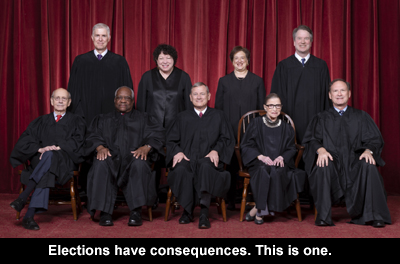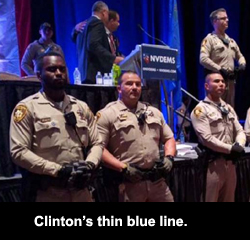Not so very long ago – within the span of many Americans’ lifetimes – crossing the southern border wasn’t that big of a deal. People from Mexico and points south would make their way into the U.S. for seasonal work mostly, do the jobs Americans tend not to want to do, then make their way back. Most of them wouldn’t stay very long because they had families back in Mexico, so they might travel back and forth as their work allowed, bringing their meager earnings back with them. There was an explicit guest worker program during World War II, but otherwise it was kind of an informal, administrative matter for many years.
Gradually, though, immigration across the southern border became more heavily policed. The option to harass migrant workers and other visitors was always available to law enforcement, but in more recent decades it became a matter of policy. As PBS journalist John Carlos Frey details in his new book, Blood and Sand, the crackdown really began in earnest during the Clinton Administration, reflected most shockingly in Clinton’s second State of the Union, which included a section on undocumented immigrants that might have been ripped from Trump’s current playbook. There were a couple of things going on in those days. Implementation of NAFTA was decimating rural agriculture in Mexico, pitting small farmers against U.S. agribusiness conglomerates. But most importantly, politicians were re-discovering the efficacy of targeting brown people. Clinton and the Republican Congress funded the construction of walls in major border cities, forcing migrants into the harsh desert and mountain terrain that straddles the border between populated areas.

Similar to Trump’s policies now, Clinton’s approach was formulated specifically to discourage people from even attempting to cross into the U.S. The result was a spike in migrant deaths as families and individuals continued to be driven north by need and in search of safety and sustenance. That policy set the template that we have operated under ever since, though Bush, Obama, and now into Trump. Of course, Trump has ratcheted up the pressure, making it impossible to adjudicate asylum claims, incarcerating immigrants regardless of their personal histories, treating all crossers like murderers, rapists, gang members, etc., holding terrified people – even children and infants – in squalid, dehumanizing conditions under the hateful eye of bigoted officers.
We have to take the administration at their word that they’re doing this to discourage migrants fleeing the remnants of the countries we worked so hard to destroy in past decades. That makes Trump and his crew terrorists, plain and simple – they are deliberately terrorizing people for political ends, and the longer we tolerate it the more complicit we are in these crimes against humanity.
luv u,
jp


 Of course, none of this would be considered disqualifying for a lifetime appointment on the nation’s highest court. That said, let’s not pretend that appointment and confirmation isn’t an intrinsically political process, much as impeachment is. If an attorney can refuse a juror based on the way he or she looks, I think it’s fair to expect that a senator has every right to reject a presidential nominee on the basis of his or her judicial philosophy. The right always attempts to characterize their “originalist” approach to constitutional law as a pragmatic practice of calling balls and strikes, following the law and the constitution as written, etc. The truth is far more complicated, of course – they have a political agenda that they’ve been pursuing relentlessly for decades while the center-left has been asleep on this issue. That’s why, even with Kennedy, we have a Supreme Court that’s well to the right of the American people.
Of course, none of this would be considered disqualifying for a lifetime appointment on the nation’s highest court. That said, let’s not pretend that appointment and confirmation isn’t an intrinsically political process, much as impeachment is. If an attorney can refuse a juror based on the way he or she looks, I think it’s fair to expect that a senator has every right to reject a presidential nominee on the basis of his or her judicial philosophy. The right always attempts to characterize their “originalist” approach to constitutional law as a pragmatic practice of calling balls and strikes, following the law and the constitution as written, etc. The truth is far more complicated, of course – they have a political agenda that they’ve been pursuing relentlessly for decades while the center-left has been asleep on this issue. That’s why, even with Kennedy, we have a Supreme Court that’s well to the right of the American people. Conway is a good con artist. I suppose you could find her convincing if you choose to forget that in 2012, Trump was birther-in-chief, claiming that his operatives were turning up “unbelievable” stuff on Obama’s birth certificate – a campaign that was always about race, about being the “other”, about legitimacy. I suppose you could buy what she’s selling if you choose to forget the last year or so of fevered rhetoric – NOT gaffes or errors, but deliberate, repeated statements – about immigration, about foreign policy, about law enforcement policy. And I suppose you could believe Conway’s contention that Trump is a hard-working, honest fellow who treats people well if you haven’t been paying attention to the last 30 years of his very public life. I guess you can believe whatever you want to believe if you try really, really hard.
Conway is a good con artist. I suppose you could find her convincing if you choose to forget that in 2012, Trump was birther-in-chief, claiming that his operatives were turning up “unbelievable” stuff on Obama’s birth certificate – a campaign that was always about race, about being the “other”, about legitimacy. I suppose you could buy what she’s selling if you choose to forget the last year or so of fevered rhetoric – NOT gaffes or errors, but deliberate, repeated statements – about immigration, about foreign policy, about law enforcement policy. And I suppose you could believe Conway’s contention that Trump is a hard-working, honest fellow who treats people well if you haven’t been paying attention to the last 30 years of his very public life. I guess you can believe whatever you want to believe if you try really, really hard.
 around whom an image-enhancement industry of sorts has been at work since his departure. But Clinton? Does anyone remember how denigrated he was throughout his presidency? I suppose people have gradually come to the realization that things weren’t so bad in the 1990s … since everything since then has pretty generally sucked.
around whom an image-enhancement industry of sorts has been at work since his departure. But Clinton? Does anyone remember how denigrated he was throughout his presidency? I suppose people have gradually come to the realization that things weren’t so bad in the 1990s … since everything since then has pretty generally sucked.